Pros
Cons
Introduction
Front
{{section_header}}{{section.name}}{{/section_header}}
The {{product.name}} is built on a chassis from corporate parent Whirlpool, so its design is similar to Amana, Whirlpool and KitchenAid offerings.
Its exterior is vertical-grain stainless steel, with through-the-door water and ice.
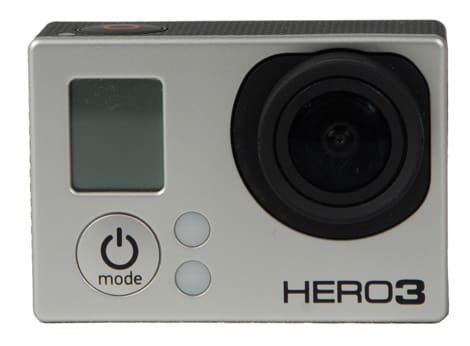

These are some of the most substantial handles we've ever felt. They're more appropriate for opening the doors of a bank vault than a fridge.

A silver colored frame surrounds the {{product.name}}'s through-the-door water and ice dispenser, which updates the overall look of the fridge's exterior.
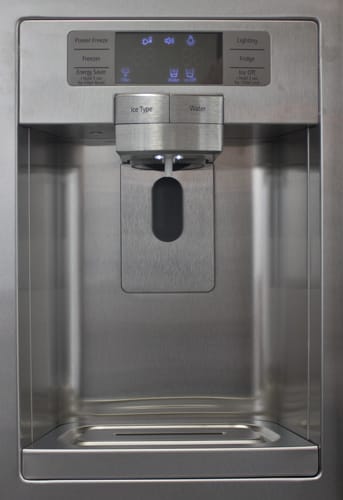
Controls are bright orange on a black background, though they don't glow intrusively unless selected.
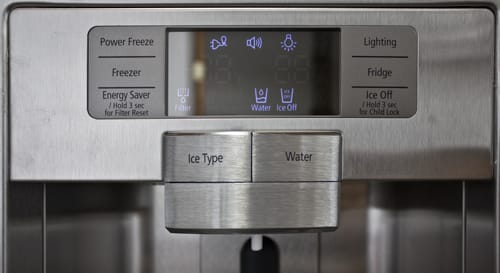
Interior
{{section_header}}{{section.name}}{{/section_header}}
Inside is an update of a classic Whirlpool interior. It's a side-by-side, alright: fridge on the right, freezer on the left.
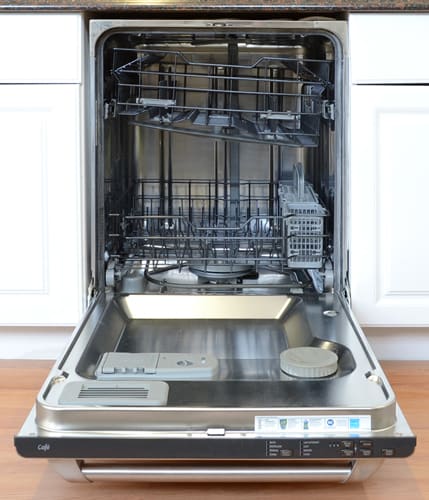
The interior of the CDWT980VSS.
One unique feature on the fridge's door is a beverage cooler. It has a separate temperature control and is meant for storing milk soda or juice.
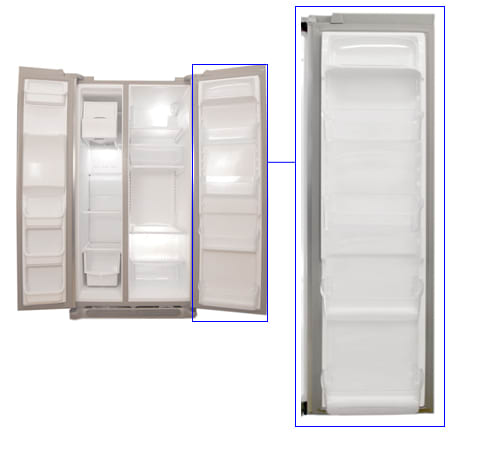
Ice is made in the top of the freezer and dispensed through the freezer door.
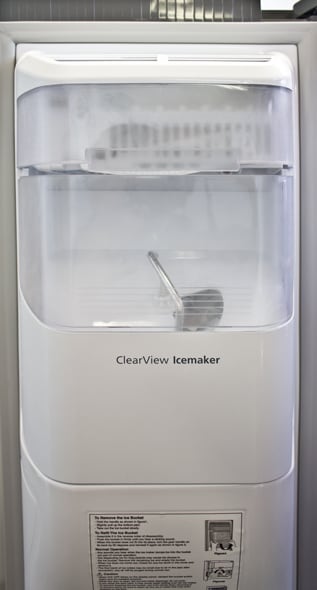
Back
{{section_header}}{{section.name}}{{/section_header}}
There's a water inlet on the back of the fridge.
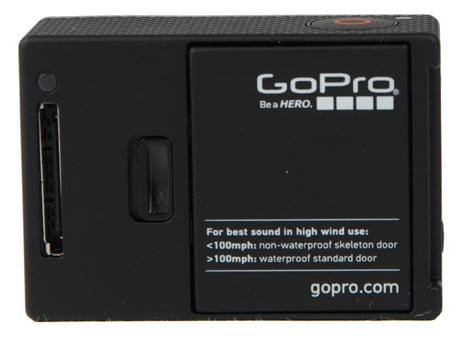
Sides
{{section_header}}{{section.name}}{{/section_header}}
The sides of the fridge are textured and gray.

Olympus SZ-31MR iHS side views
Running Cost
{{section_header}}{{section.name}}{{/section_header}}
Assuming that power sells for 9.1 cents per kWh where you are, a year with the {{product.name}} would only set you back $35.70. That's very low for a fridge, regardless of its capacity.
Power Use Per Cu Ft
{{section_header}}{{section.name}}{{/section_header}}
We divide out power consumption by usable interior space to determine how much a fridge costs compared to its competitors. The {{product.name}} only runs 0.08 kWh/cubic foot, which is very low.
Fridge Temperature
{{section_header}}{{section.name}}{{/section_header}}
The {{product.name}} had no issues maintaining an even temperature over time. That lack of variation is protection against your food spoiling prematurely. Food on the bottom shelf did stay consistently slightly warmer than the top two, though. Keep that in mind if you're storing dairy or other sensitive items down there.
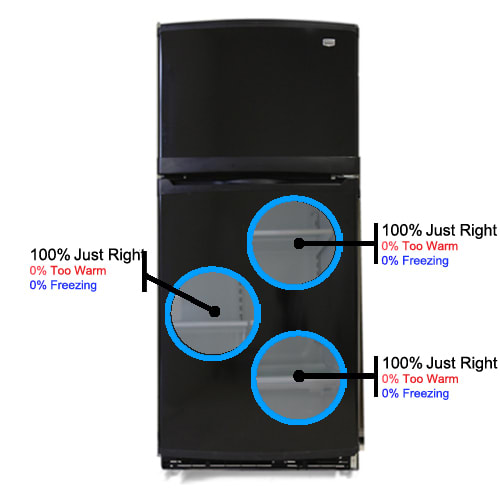
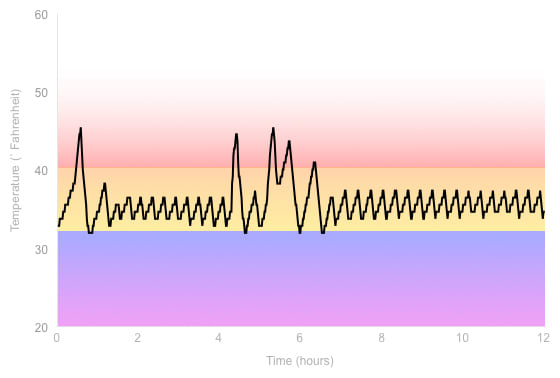
Freezer Temperature
{{section_header}}{{section.name}}{{/section_header}}
Like the fridge, the freezer kept food at constant temperatures throughout our testing. Temperature variation is how frozen food gets freezer burn, so that's a good thing. Also like the fridge, food was a little warmer at the bottom of the freezer compartment than at the top. The top of the freezer is next to the ice maker and vent, so food may get a little more exposure to cold air up there.
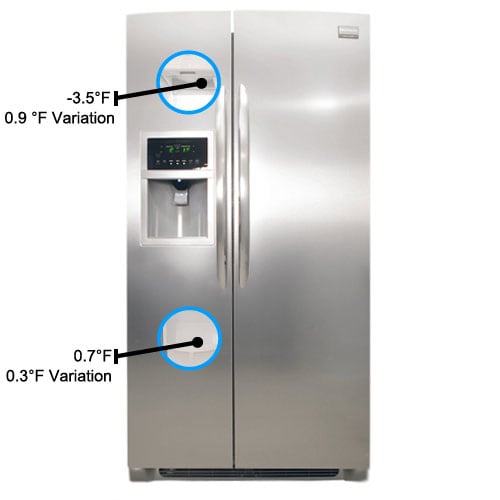
Vegetable Drawer
{{section_header}}{{section.name}}{{/section_header}}
A vegetable drawer is meant to keep moisture trapped in its contents. That's exactly what the {{product.name}} did, letting our test simulated vegetable lose only 0.08 grams of water per hour. That's very low compared to other fridges that lose three times that amount.
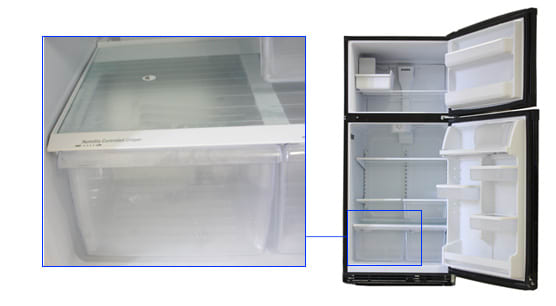
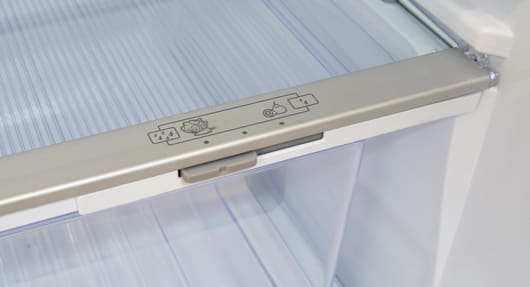
Power Loss
{{section_header}}{{section.name}}{{/section_header}}
When the power goes out, you stand to lose a lot of food. That's why we unplug our fridges to ensure they can keep food cold based on the merits of their insulation alone. After 36 hours, the internal temperature of food inside the {{product.name}}'s freezer was still below 32 degrees Fahrenheit.
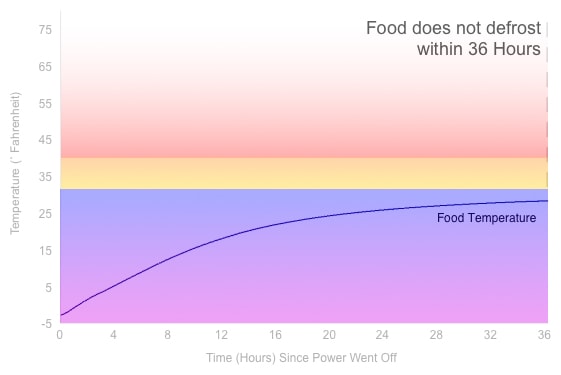
Freezing Performance
{{section_header}}{{section.name}}{{/section_header}}
The {{product.name}} took quite awhile to freeze food from room temperature -- over two hours. That means food could be in danger of developing ice crystals that affect its temperature when thawed out.
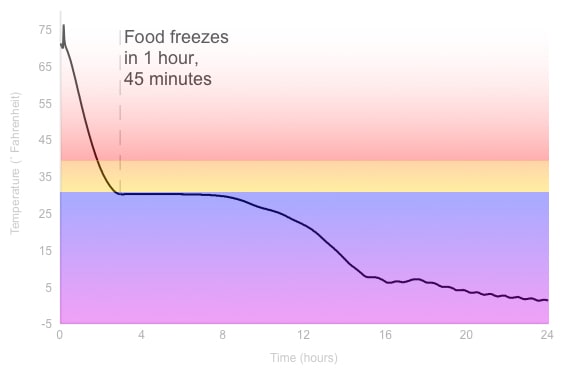
Usable Space
{{section_header}}{{section.name}}{{/section_header}}
The main fridge cavity features two adjustable shelves, a fixed shelf, a deli drawer, general storage drawer and one humidity-controlled drawer. Shelves are held in place by grooves built into the side of the fridge.
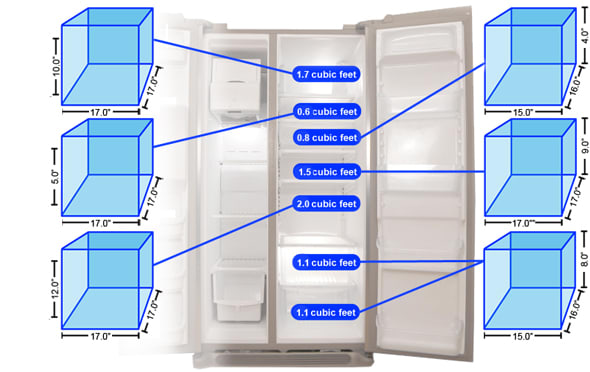
On the fridge door, there's a dairy bin, two adjustable shelves and one fixed shelf. Its most prominent feature, however, is a "beverage chiller" -- a set of doors that open to reveal a compartment for storing milk, soda and juice. It's separately vented when the door is closed, and it has its own temperature control. If you store a lot of beverages, this may be a good choice for you. Otherwise, a purpose-built shelf may not be the most efficient use of space.
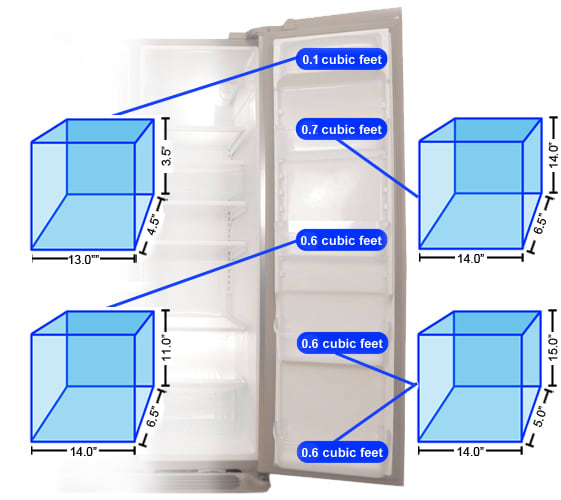
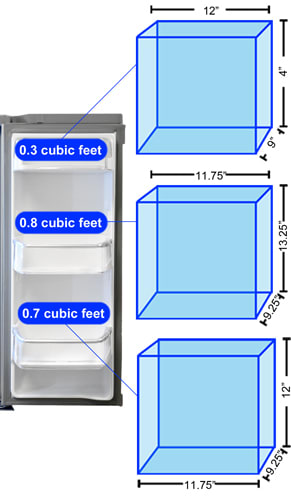
On the left, the freezer has minimally adjustable wire shelves and one drawer. There's no real usable storage space above the ice maker.
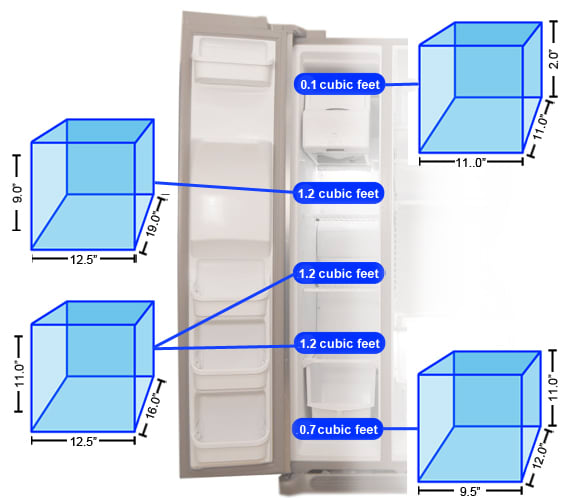
The freezer door has some storage space eaten up by the ice maker chute. Otherwise, there are four fixed shelves.
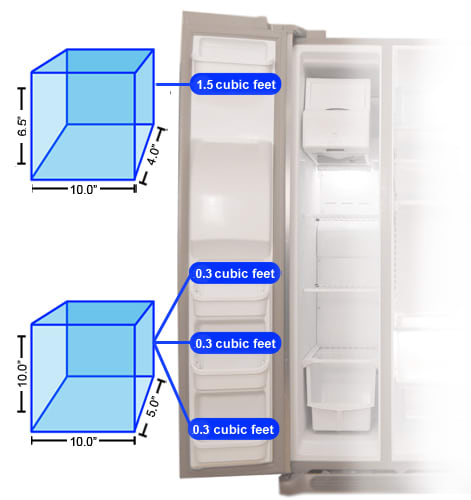
Below are the manufacturers own figures for capacity, and our own measurements for usable capacity. The manufacturers figures do not take account of the shelves, drawers and other removable features, but our measurements do account for the space these take up.
Ease of Access
{{section_header}}{{section.name}}{{/section_header}}
The benefit of a side-by-side fridge is that you can store frequently-used fridge and freezer items at a convenient height. The wide {{product.name}}'s shelves are easy to slide in and out of place, too.
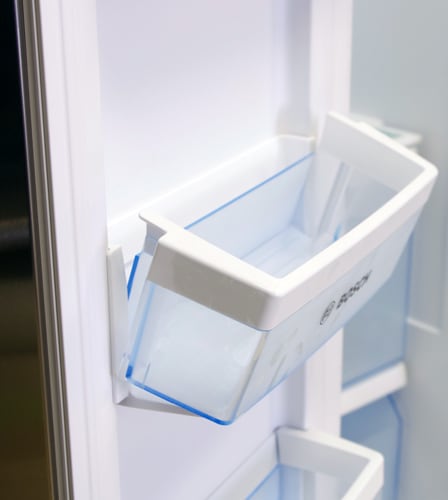
Controls
{{section_header}}{{section.name}}{{/section_header}}
The {{product.name}}'s temperature controls are separate for fridge and freezer. They lack any corresponding temperature scale.

Water Dispenser
{{section_header}}{{section.name}}{{/section_header}}
Instead of levers, the {{product.name}} requires that you push a button for water. Press the glass back and you'll get ice instead. The water spout is a little close to the edge of smaller tumblers, so you may get some splashing. Overall, there's a bit of a learning curve here, and we'd prefer a simple two-lever design.

Ice Maker
{{section_header}}{{section.name}}{{/section_header}}
Ice is made in the top of the freezer and dispensed through the freezer door.

Cleaning
Noise
Other Features
{{section_header}}{{section.name}}{{/section_header}}
{{product.manufacturer_specs['Other Features Photo BROKEN?']}}
Specs
{{section_header}}{{section.name}}{{/section_header}}
The two fridges have similar specs and costs, though the Maytag has better temperature performance.
Design
{{section_header}}{{section.name}}{{/section_header}}
Both fridges have stainless exteriors and through-the-door water and ice.
Performance
{{section_header}}{{section.name}}{{/section_header}}
The Maytag has more even temperature performance in both the fridge and freezer.
{{score_bars comp_num="1", scores="Power Use Rating, Running Cost Rating, Fridge Temperature Rating, Power Loss Rating, Freezer Temperature Rating, Freezing Test Rating"}}
Storage Space
{{section_header}}{{section.name}}{{/section_header}}
Both fridges would work for a large family, as they have cavernous interiors.
{{score_bars comp_num="1", scores="Freezer Usable Space Rating, Fridge Usable Space Rating"}}
Usability
{{section_header}}{{section.name}}{{/section_header}}
If you store a lot of beverages, the Maytag's beverage chiller may be an interesting feature for you. Otherwise, its wasted space.
{{score_bars comp_num="1", scores="Usability Ease of Access Rating , Usability Controls Rating, Usability Water Rating, Usability Icemaker Rating, Usability Cleaning Rating"}}
Specs
{{section_header}}{{section.name}}{{/section_header}}
The two fridges cost the same, though the GE has a "clean steel" exterior and better shelving.
Design
{{section_header}}{{section.name}}{{/section_header}}
The Maytag's all-stainless exterior with silver ice dispenser looks more modern than the GE's clean steel and thick black plastic.
Performance
{{section_header}}{{section.name}}{{/section_header}}
The Maytag had slightly fewer variations in temperature across different shelves, though both did a good job keeping food at consistent temperatures over time.
{{score_bars comp_num="2", scores="Power Use Rating, Running Cost Rating, Fridge Temperature Rating, Power Loss Rating, Freezer Temperature Rating, Freezing Test Rating"}}
Storage Space
{{section_header}}{{section.name}}{{/section_header}}
Both fridges have similar interior space.
{{score_bars comp_num="2", scores="Freezer Usable Space Rating, Fridge Usable Space Rating"}}
Usability
{{section_header}}{{section.name}}{{/section_header}}
We really liked the GE's interior, with slide-out shelves that made it easier to find food hidden in the back of the fridge.
{{score_bars comp_num="2", scores="Usability Ease of Access Rating , Usability Controls Rating, Usability Water Rating, Usability Icemaker Rating, Usability Cleaning Rating"}}
Specs
{{section_header}}{{section.name}}{{/section_header}}
From the same corporate parent, the KitchenAid has marginally better performance but is smaller and costs $300 more.
Design
{{section_header}}{{section.name}}{{/section_header}}
The costlier KitchenAid actually looks older, with black plastic cladding and very visible top hinges.
Performance
{{section_header}}{{section.name}}{{/section_header}}
We were impressed by the test results of each fridge: even cooling over time, slight variations depending on where food was stored. The KitchenAid's smaller freezer compartment did bring food below freezing faster than the Maytag could, however.
{{score_bars comp_num="3", scores="Power Use Rating, Running Cost Rating, Fridge Temperature Rating, Power Loss Rating, Freezer Temperature Rating, Freezing Test Rating"}}
Storage Space
{{section_header}}{{section.name}}{{/section_header}}
The KitchenAid is the smaller fridge, with much narrower interior cavities.
{{score_bars comp_num="3", scores="Freezer Usable Space Rating, Fridge Usable Space Rating"}}
Usability
{{section_header}}{{section.name}}{{/section_header}}
Both fridges have nearly identical interiors, though they're customized for their individual brands.
{{score_bars comp_num="3", scores="Usability Ease of Access Rating , Usability Controls Rating, Usability Water Rating, Usability Icemaker Rating, Usability Cleaning Rating"}}
Conclusion
Energy Efficiency
The fridge will cost you a little under $36 a year to run. That's much better than some competing appliances.
Performance
The {{product.name}} had a little trouble freezing room temperature foods, but otherwise temperature performance was impressive with little variation over time.
Storage Space
Side-by-sides are narrow, but the {{product.name}} has enough storage space that you should have no trouble storing food -- unless its a large pizza or sheet cake.
Usability
The {{product.name}} has a dedicated spot for milk, soda or other beverages. It takes up a lot of space on the door and dedicates it to one kind of food. The ice maker has a bit of a learning curve, too -- so expect to clean up spills if guests are over.
Meet the tester
Keith was the Editor in Chief of Reviewed's appliance and automotive sites. His work has appeared in publications such as Wired, Car & Driver, and CityLab.
Checking our work.
Our team is here to help you buy the best stuff and love what you own. Our writers, editors, and experts obsess over the products we cover to make sure you're confident and satisfied. Have a different opinion about something we recommend? Email us and we'll compare notes.
Shoot us an email